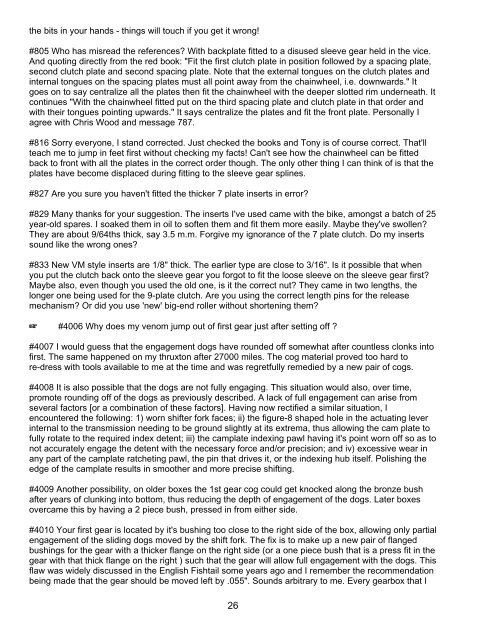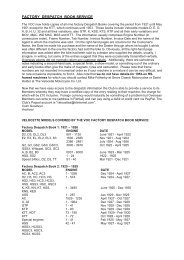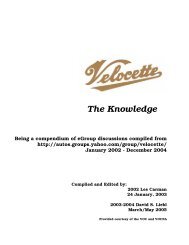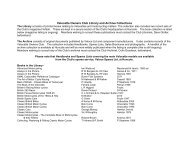The Knowledge - Velocette Owners Club
The Knowledge - Velocette Owners Club
The Knowledge - Velocette Owners Club
Create successful ePaper yourself
Turn your PDF publications into a flip-book with our unique Google optimized e-Paper software.
the bits in your hands - things will touch if you get it wrong!<br />
#805 Who has misread the references? With backplate fitted to a disused sleeve gear held in the vice.<br />
And quoting directly from the red book: "Fit the first clutch plate in position followed by a spacing plate,<br />
second clutch plate and second spacing plate. Note that the external tongues on the clutch plates and<br />
internal tongues on the spacing plates must all point away from the chainwheel, i.e. downwards." It<br />
goes on to say centralize all the plates then fit the chainwheel with the deeper slotted rim underneath. It<br />
continues "With the chainwheel fitted put on the third spacing plate and clutch plate in that order and<br />
with their tongues pointing upwards." It says centralize the plates and fit the front plate. Personally I<br />
agree with Chris Wood and message 787.<br />
#816 Sorry everyone, I stand corrected. Just checked the books and Tony is of course correct. That'll<br />
teach me to jump in feet first without checking my facts! Can't see how the chainwheel can be fitted<br />
back to front with all the plates in the correct order though. <strong>The</strong> only other thing I can think of is that the<br />
plates have become displaced during fitting to the sleeve gear splines.<br />
#827 Are you sure you haven't fitted the thicker 7 plate inserts in error?<br />
#829 Many thanks for your suggestion. <strong>The</strong> inserts I've used came with the bike, amongst a batch of 25<br />
year-old spares. I soaked them in oil to soften them and fit them more easily. Maybe they've swollen?<br />
<strong>The</strong>y are about 9/64ths thick, say 3.5 m.m. Forgive my ignorance of the 7 plate clutch. Do my inserts<br />
sound like the wrong ones?<br />
#833 New VM style inserts are 1/8" thick. <strong>The</strong> earlier type are close to 3/16". Is it possible that when<br />
you put the clutch back onto the sleeve gear you forgot to fit the loose sleeve on the sleeve gear first?<br />
Maybe also, even though you used the old one, is it the correct nut? <strong>The</strong>y came in two lengths, the<br />
longer one being used for the 9-plate clutch. Are you using the correct length pins for the release<br />
mechanism? Or did you use 'new' big-end roller without shortening them?<br />
L #4006 Why does my venom jump out of first gear just after setting off ?<br />
#4007 I would guess that the engagement dogs have rounded off somewhat after countless clonks into<br />
first. <strong>The</strong> same happened on my thruxton after 27000 miles. <strong>The</strong> cog material proved too hard to<br />
re-dress with tools available to me at the time and was regretfully remedied by a new pair of cogs.<br />
#4008 It is also possible that the dogs are not fully engaging. This situation would also, over time,<br />
promote rounding off of the dogs as previously described. A lack of full engagement can arise from<br />
several factors [or a combination of these factors]. Having now rectified a similar situation, I<br />
encountered the following: 1) worn shifter fork faces; ii) the figure-8 shaped hole in the actuating lever<br />
internal to the transmission needing to be ground slightly at its extrema, thus allowing the cam plate to<br />
fully rotate to the required index detent; iii) the camplate indexing pawl having it's point worn off so as to<br />
not accurately engage the detent with the necessary force and/or precision; and iv) excessive wear in<br />
any part of the camplate ratcheting pawl, the pin that drives it, or the indexing hub itself. Polishing the<br />
edge of the camplate results in smoother and more precise shifting.<br />
#4009 Another possibility, on older boxes the 1st gear cog could get knocked along the bronze bush<br />
after years of clunking into bottom, thus reducing the depth of engagement of the dogs. Later boxes<br />
overcame this by having a 2 piece bush, pressed in from either side.<br />
#4010 Your first gear is located by it's bushing too close to the right side of the box, allowing only partial<br />
engagement of the sliding dogs moved by the shift fork. <strong>The</strong> fix is to make up a new pair of flanged<br />
bushings for the gear with a thicker flange on the right side (or a one piece bush that is a press fit in the<br />
gear with that thick flange on the right ) such that the gear will allow full engagement with the dogs. This<br />
flaw was widely discussed in the English Fishtail some years ago and I remember the recommendation<br />
being made that the gear should be moved left by .055". Sounds arbitrary to me. Every gearbox that I<br />
26





